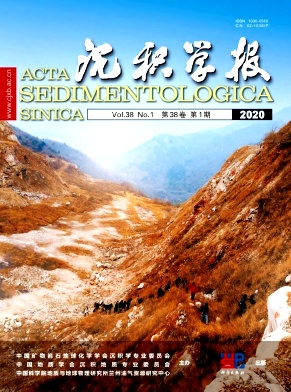HTML
-
微生物包括生物界古菌域、细菌域和真核生物域的所有微小生物,具有生长繁殖快、代谢能力强等特点。这使得其在地球上分布广泛,数量巨大。微生物也是地球上出现最早的生物,约38亿年前就在地球上发现了微生物的踪迹,随后不断发展,最终广泛地分布在地球表层各种环境中。微生物以其巨大的生物量,广泛参与了地球表面沉积物的形成、沉积和成岩过程[1]。前寒武纪以微生物生态系为主导,后生动物相对缺乏,微生物对地球环境的改变、地层的沉积以及生物的进化都发挥了重要作用。
我国中元古代海相地层分布广泛,海洋沉积物代表着物理的、化学的和生物的3种不同过程的混合作用结果,对全球古气候和古环境的研究具有不可比拟的优势。在中元古代的海洋条件下,微生物很难保存为化石,因此对于中元古代海洋的研究缺少生物化石方面的记录。而前寒武纪丰富的生物成因沉积构造能代表当时微生物群落的繁盛和生物沉积特征,如广泛发育在碳酸盐岩地层的叠层石和发育在碎屑岩地层中的“微生物成因沉积构造(Microbially Induced Sedimentary Structures,简称MISS)”。华北地区中元古代地层发育完整且沉积连续,是古元古代末期华北克拉通化后的第一套沉积盖层,和其他地区相比,变质程度低,能够较好地保存当时的沉积特征,用于古环境及生物演化的分析[2-7]。豫西隶属于华北板块南缘,云梦山组在该区广泛发育,为一套滨浅海碎屑岩沉积,发育有丰富的MISS,且类型多样,可以作为研究古海洋和古气候的重要窗口。
-
豫西地区地处华北陆块南缘,元古宙地层十分发育,主要有古元古界上部的熊耳群、上覆的中新元古界汝阳群、洛峪群及相当地层。研究区河南鲁山县下汤镇发育了较为完整的中—新元古代地层(云梦山组至洛峪口组),且露头连续,是我国研究华北前寒武纪地质问题最理想的地区之一(图 1)。本研究以鲁山县下汤镇大黑潭沟云梦山组为主要剖面,地层区划属华北地层区豫西地层分区渑池—确山地层小区。
豫西的云梦山组属于汝阳群,一般被归为中元古代,基本与冀北的蓟县系相当。下伏地层为熊耳群,相当于长城系的上部,发育典型的火山岩沉积,是研究区最发育的地层之一。汝阳群和熊耳群呈角度不整合接触,由下而上分为3个组:1)云梦山组:其底部多见磨圆度较好的砾岩或含砾粗砂岩,厚几十厘米至几十米不等,向上发育砂岩、泥岩和粉砂岩沉积,层面MISS发育丰富。2)白草坪组:多见泥砂互层,层面偶见MISS发育,且从下至上,泥质成分增加。3)北大尖组:下段以碎屑岩为主,泥岩成分较多,上段以砂屑白云岩、砾屑白云岩为主[8]。汝阳群地层具有穿时性的特征,上覆地层为洛峪群,与其呈平行不整合接触,自下而上的崔庄组、三教堂组和洛峪口组呈整合接触(图 2)。汝阳群和洛峪群为一套滨海—浅海相沉积,代表着多次的海进海退事件。汝阳群下部以陆源碎屑的潮坪沉积为主,上部和洛峪群以陆源碎屑至富含叠层石的碳酸盐岩沉积为主。研究区云梦山组剖面主要为紫红色、灰白色的细—粗粒厚层石英砂岩为主,部分层位夹有少量紫红色页岩,向上夹页岩层数增多;云梦山组底部则为厚层状砾岩,砾石磨圆度好,主要为铁质胶结,向上夹有暗红色安山岩。该组地层交错层理十分发育,层面波痕多见,总体属于滨浅海陆屑沉积,其中潮坪沉积非常发育[9-13]。
-
MISS作为一种生物沉积构造,是微生物群落与沉积环境相互作用的产物。微生物在生长和新陈代谢、以及物理破坏和生物腐败等过程中,在沉积物中留下的各种形态、一般不突出于底层面的原生沉积构造。广义上也可被视为遗迹化石的一种[14-18]。Noffke [17]将其定义为第五类原生沉积构造,包括层面构造和层内构造,以层面构造为主。MISS在云梦山组非常丰富,现已被鉴定的约25种,在本组的中、上段紫红色或肉红色砂岩层面上多见,特别是石英砂岩与薄层泥—粉砂岩的接触面上最为丰富。这种层面构造经常与同样发育在层面的波痕伴生,且呈现多样性特征。云梦山组的MISS按成因分类方案[19]可分为微生物席生长相关构造(Mat growth features),微生物席代谢相关构造(Mat metabolism features)、微生物席破坏相关构造(Mat destruction features)和微生物席腐烂相关构造(Mat decay features)四大类。这种分类方式只是大体分类,其实许多构造的形成是多成因的,如气隆构造(Gas domes),是一种由气体形成的构造,气体可以来自于微生物席生长时的光合作用,也可以由微生物席腐败过程产生[9, 20]。云梦山组发育的生长相关构造包括被所定居微生物席(膜)改造的波痕,如较典型波痕补丁(Patchy ripples)(图 3e)、负载波痕(Loaded ripples)、变余波痕(Palimpsest ripples)等;由于微生物群落不规则生长而形成的簇状突起,以及和微生物席(膜)生长相关的多种皱饰构造(Wrinkle structures),如象皮构造(Old elephant skins)和肯尼亚波痕(Kinneyia ripples)(图 3g,h)。微观上观察到的矿物层可作为代谢相关构造类型(图 4f)。破坏相关构造在云梦山组发育最为丰富,包括多种席裂构造(Mat cracks)(从纺锤形、到多边形以及曲形等各种形态的脱水裂痕)(图 3a~d)、微生物席砂片(Mat chips)(图 3i)等。腐烂构造主要来源于微生物腐烂过程中有机质的分解过程,以气隆构造(Gas domes)(图 3j)和砂火山(Sand volcanos)(图 3f)为典型[9]。
云梦山组的MISS数量多,类型全面。对MISS的镜下观察也发现了多种微生物席形成的微结构类型[9](图 4e,f)。这些微结构进一步证实了微生物席的曾经存在[21, 22]。微生物纹层的出现(图 4d)和MISS在层面的多次发育代表着微生物席的多次的频繁的定居(图 4a~c),揭示了当时微生物群落在元古时期的大繁荣,而且繁盛了很长一段时间。
云梦山组发现的部分MISS类型在华北大红峪组、串岭沟组,山西黎城常州沟组以及贺兰山地区的黄旗口组等中元古代地层也有发现[23-27]。豫西云梦山组与这些地区所发现的MISS类型在形态方面有很强的可对比性。但是云梦山组MISS发育的规模更大,类型更加多样,这对于华北地区的中元古代古环境的研究将具有重要意义。
-
云梦山组发育的MISS数量大,种类多。从广泛发育的微生物纹层和MISS在相邻层面多次出现来看,当时微生物群落是非常繁盛的,而且这种繁盛持续了很长一段时间。云梦山组MISS的丰度和多样性都表明当时的古环境是适宜微生物席生长的适宜环境:气候温暖的滨浅海环境,水动力适中,沉积物泥质含量较少,以蓝细菌为主导的微生物群落在此定居且繁盛。因此,MISS的大量广泛地发育可以作为温暖且较浅水体的古环境标志。
中元古代是地史上重要的转折期,从这个时期开始,华北克拉通之上的稳定盖层开始发育,全球构造格局、古地理及生物界面貌发生了重大变化[28]。原核生物在这一时期表现为大范围的大发展、大繁荣,同时这种大发展也孕育出了多细胞真核生物如宏观藻类。因此,中元古代也是生物进化史上的一个关键时期。据古地磁的研究,中国中、晚元古代都处于中纬度到低纬度区范围内,气候具有温暖而潮湿的特征,地表温度大约在50 ℃~20 ℃之间[10],也为微生物包括蓝细菌的大量繁殖提供了条件。因此,云梦山组MISS的大量发育验证了当时的环境特征。笔者在早三叠世陆相地层中也发现有MISS发育,形态和类型与云梦山组MISS具有相似性,同样代表着温暖气候和浅水特征,同时,由于其代表着此地区二叠纪末期生物大灭绝后首现的生物群落,可能具有更重要的生态学意义[29-31]。
-
目前已报道的MISS最早见于太古代地层[21],在中—新元古代的海相沉积中多见,发育在中、细砂岩层面上,多出现在潮下带上部到潮上带下部的环境中。显生宙的生物危机期后的地层也见发育,并被作为一种错时相类型[30-31]。由于微生物席的生长受到局限环境的制约,MISS分布也具有局限性,对古环境的指示受到限制。但是由于MISS每种类型发育时有各自的生境特点,因此在精细环境的指示方面具有优势,代表着定居的微生物席的古环境特征。微生物在生长对沉积物会产生障积、捕获和黏结作用;微生物及其周围的EPS,形成了适于化学反应的小环境,有助于矿物的形成和富集;微生物死后的有机体埋藏也产生了一系列的生物化学反应。这些过程和外界环境的作用相结合,就形成了各种形态的MISS。如云梦山组最常见的破坏相关构造,代表着较动荡的环境或微生物席被搬运的特征,其中各种席裂构造的出现具有很重要的指示意义,表明微生物席暴露地表和脱水收缩的特性,这种构造最可能出现的环境是潮间带至潮上带下部[9, 14, 20, 32]。研究区云梦山组发育了多种类型的席裂构造,它们的形态主要由微生物席厚度和暴露时间的长短控制。估算的形态从纺锤形开始,到曲形或封闭的多边形,如果不考虑其他因素的影响,这种变化揭示了微生物席暴露的时间在逐渐增加。裂痕的深度还可用来估算微生物席的厚度。在现代潮坪环境的不同区域,MISS的形态是有差别的,可作为精细环境指示的标志[33-34],如Bose et al. [33]在Texas海岸碎屑岩潮坪总结的MISS分布特征(图 5a)。

Figure 5. Distribution of MISS in tidal flats, Yunmengshan Fm, Lushan section compared with modern tidal flats
云梦山组的MISS多发育在潮坪环境,潮坪环境多样化的小生境定居了微生物席的不同生态型,在不同的外界环境影响下,MISS类型多样化明显。微生物席破坏相关构造仍然是发育的最丰富类型,其在潮坪环境下发育的MISS种类多样,如多种类型的席裂构造、微生物席砂片等。云梦山组潮坪环境的整体分布见图 5b。多边形脱水裂痕广泛分布,可以发育在潮坪的大部分区域,但大小和规模上会有所区别。在潮间带发育的多边形脱水裂痕较为小型,较大型的多边形脱水裂痕往往发育在潮上带的某些区域,可能是潮上的特殊区域能生长较厚的微生物席所致。气隆构造及皱饰构造的某些类型具有相似的成因,常见于潮间带和潮上带的部分区域,指示浅水和弱水动力。但相比较而言,皱饰构造有些种类对水动力状况的适应更广泛一些,可发育于水下环境或较强水动力,如象皮构造常见于波痕面上。整体来看,云梦山组MISS的发育和现代潮坪相比具有相似特征(图 5),这种对古环境的精细指示是生物成因构造的优势所在。由于埋藏和保存等原因,会使保存下来的MISS和当时其形态有一定的差异。即便如此,云梦山组保存的MISS类型多样化,形态和现代MISS具有可比性,因此,对沉积环境具有精细指示作用。
-
云梦山组的MISS数量大,类型多,表明当时微生物群落非常繁盛,这种繁盛对当时环境的最大影响可能就是对大气圈和水圈的充氧,氧气含量的提高也为生物的进化指示了方向。就早期地球的环境来看,最早定居在地球的应该是厌氧细菌,以化能异养方式氧化有机化合物。随着光合产氧微生物(以蓝细菌为主)的出现,地球大气逐渐变得富含氧气。氧气是一种很强的氧化剂,对厌氧原核生物带来了严重威胁。为应答这种进化压力,微生物的某些谱系产生出需氧细菌。需氧菌可以通过从有机分子把电子传递给氧气来获取能量的,这个过程释放大量能量,所以在含氧环境中需氧生物比厌氧生物具有能量方面的优越性。这种优越性使得需氧生物在富氧环境中占据优势。这种优势也带来了海洋初级生产力的大量提高,为生物界的进一步发展提供基础[35]。
从另一个角度来看,原核细胞光合作用的进化在第一次大氧化事件之前已经完成,蓝细菌成为这时期光合作用的主体。蓝细菌进一步进化出抵抗恶劣环境的细胞如异形胞大约在24亿年前[36]。至云梦山组所处的中元古代,作为微生物席主体的蓝细菌已经进化到适应环境的顶端,成为优势种群。这个时期广泛发育在碎屑岩中的微生物成因沉积构造和碳酸盐岩沉积中的微生物岩,证实了此时的生物界状况。在这个时期,产氧光合微生物以其巨大的生物量对地球环境的改造发挥了巨大的作用。从云梦山组的MISS的数量来看,微生物的数量非常巨大,20亿年前的地球大氧化事件(其成因被认为是多方面的,生物的光合作用被认为是原因之一[37-38])之后的中元古代,大气圈和水圈的充氧应该是以微生物光合作用为主导的。从这个时期开始,生物在地球环境改造中的重要性将越来越不可忽视。大气含氧量从现今大气氧的0.1倍快速增加,到元古代末期,接近到显生宙的水平(仍低于现今水平),氧气含量显著升高[38-40]。同时,原核生物的大繁荣也为真核生物的出现提供了基础,真核生物的起源也在这个时期。因此,中元古代MISS的大量发育揭示出以蓝细菌为优势的微生物群落发展到顶峰,为生物的进一步进化提供了基础。
3.1 微生物成因沉积构造在云梦山组的繁盛及古环境指示
3.2 云梦山组微生物成因沉积构造类型对沉积环境的精细指示
3.3 中元古代微生物群落对古环境的强大改造能力
-
豫西鲁山中元古界云梦山组位于华北板块南缘,以厚层紫红色砂岩为特征,属于滨浅海碎屑岩沉积,层面发育了大量的MISS,数量丰富,类型多样。按成因分类可将云梦山组发育的MISS归为微生物席生长相关构造、微生物席代谢相关构造、微生物席破坏相关构造和微生物席腐烂相关构造四大类。云梦山组的MISS数量大,类型多,分布广,表明当时微生物群落非常繁盛,从而指示了云梦山组沉积时的古环境特征—温暖的滨浅海。MISS的不同类型还可以作为精细环境指示的标志。另外,从生物进化的角度来看,此时的蓝细菌也已进化到较高的程度,成为微生物席群落的优势种类,因此MISS的大量发育揭示了以蓝细菌为主导的微生物群落的繁盛,使产氧光合作用得以大量进行,大气的氧气含量显著升高,从现今的约0.1倍到接近显生宙的水平。这种强大的改造功能和当时巨大的微生物量相一致。水圈的氧化也在同时进行,为真核生物的出现打下了基础。











 DownLoad:
DownLoad:



